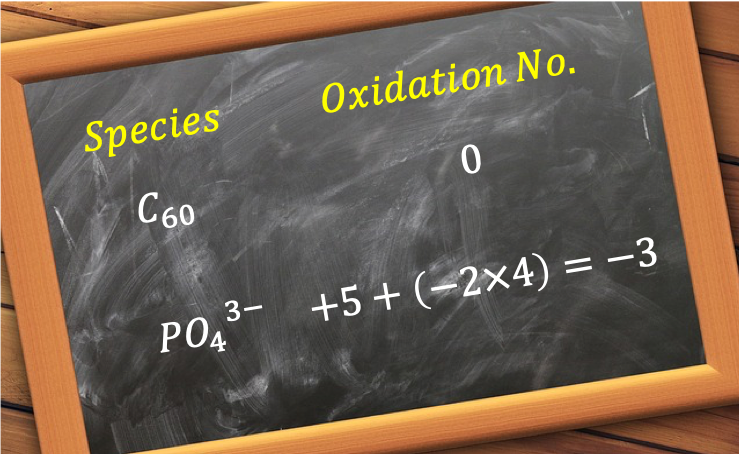The oxidation state/number of an atom or a monatomic ion is a number assigned to the atom or monatomic ion that corresponds to its degree of oxidation.

The rules for assigning an oxidation state/number to an atom or monatomic ion is as follows:-
-
- The oxidation state/number of an uncombined atom or an atom in a neutral homonuclear molecule is zero, e.g.
|
Atom |
Oxidation state/number |
|
|
Cu |
Cu |
0 |
|
Cl2 |
Cl |
0 |
|
C60 |
C |
0 |
-
- The oxidation state/number of a monatomic ion is equal to its charge, e.g.
|
Ion |
Oxidation state/number |
|
Fe3+ |
+3 |
|
Cl– |
-1 |
|
Na+ |
+1 |
-
- The oxidation state/number of an atom in a compound corresponds to the number of electrons the atom gains or loses when it hypothetically forms ionic bonds with its neighbours, e.g.
|
Compound |
Atom | Assumed role |
Oxidation state/number |
|
MgCl2 |
Mg | Electron donor |
+2 |
|
CO2 |
C | Electron donor |
+4 |
|
KOH |
O | Electron acceptor |
-2 |
|
NH3 |
N | Electron acceptor |
-3 |
-
- The total oxidation state/number of all atoms in a species is equivalent to the overall charge of the species, e.g.
|
Species |
Overall charge of species |
Oxidation state/number |
|
NaCl |
0 |
+1 + (-1) = 0 |
|
NH4+ |
+1 |
-3 + (+1 x 4) = +1 |
|
PO43- |
-3 |
+5 + (-2 x 4) = -3 |

Question
Determine the oxidation state/number of the underlined elements in AlH3, CH4 and Cr2O72-.
Answer
For AlH3, we assume that Al is the electron donor as it is more electropositive than H, and so, +3 + (H x 3) = 0. Therefore, H = -1.
For CH4, we assume that H is the electron donor as it is more electropositive than C, and so, C + (+1 x 4) = 0. Hence, C = -4.
For Cr2O72-, we assume that Cr is the electron donor as it is more electropositive than O, and so, (Cr x2) + (-2 x 7) = -2. Therefore, Cr = +6.